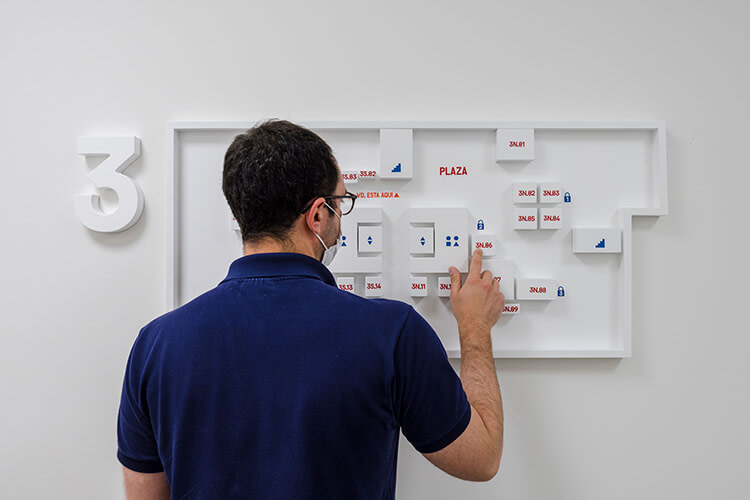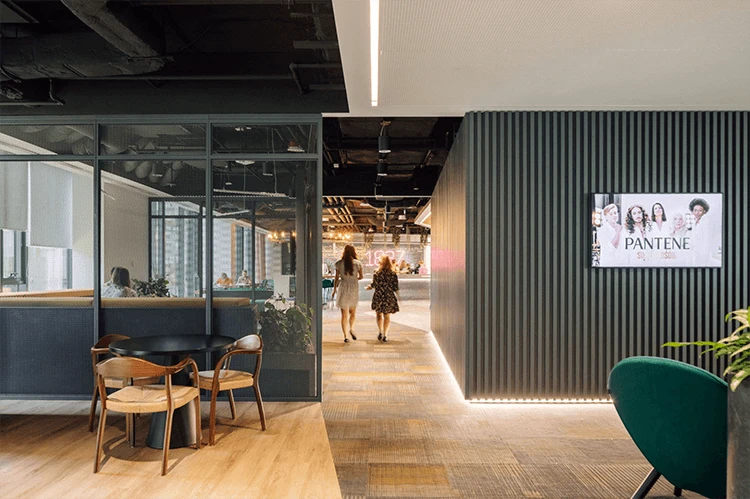12/5/2023
Creating Workspaces that Work for Everyone
P&G’s Universal Design approach drives accessibility and inclusivity.

Our Beijing, China, office includes a low-stimuli area that offers team members a quiet, natural setting for meetings or focused work.
What if you showed up to work but couldn’t get through the front door? Or you could see your co-workers having lunch outside, but physical barriers kept you from joining them?
Hurdles like these can cause significant problems for people with disabilities — and leave them feeling excluded. We’re making P&G workspaces more equitable by applying the principles of Universal Design to create environments that are usable by all, without the need for adaptation.

At our headquarters in Cincinnati, Ohio, heavy entrance doors have been replaced with automatic doors for easier accessibility.
Today, automatic sliding doors stand where enormously heavy doors once hindered entrance to P&G’s headquarters in Cincinnati, Ohio. New ramps provide easier access to sun-filled outdoor terraces in Geneva, Switzerland, and São Paulo, Brazil.

Frederik Spittael, global architect for P&G
“The beauty is it makes sense for everyone, not just for people with disabilities,” said Frederik Spittael, global architect for P&G. “It’s just a better human experience.”
Spittael leads the Company’s Workplace Design team, with responsibility for general offices, headquarters and Research & Development centers and recently won a 2023 P&G Global Equality and Inclusion Award for driving more accessibility and inclusivity in P&G facilities around the world.
LEARN MORE: Celebrating International Day of People with Disabilities
Spaces that Make People Feel Valued
The team’s Universal Design focus goes beyond basic accessibility design and code compliance checklists, turning the conversation from disability to inclusivity. It’s a mission Spittael is passionate about.
“People aren’t disabled — access is disabled by buildings that don’t properly meet the needs of users.” said Spittael.
At P&G, we believe all employees, with their unique talents and lived experiences, should have the opportunity to succeed, develop and grow and — in turn — inspire growth for our business through accessible innovation in our products, services and communications.
The Workplace Design team’s efforts directly support the Company’s commitments to Equality and Inclusion and a superior employee experience. At the Reading Innovation Centre (RIC) in England, the new lab makes employees feel valued, welcomed and comfortable being themselves.

In Madrid, Spain, tactile maps make for easier building navigation for those with visual impairments.
Decal stickers on the building’s revolving doors help visually impaired employees like Jo Mangan, a technical director in Quality Assurance who has macular degeneration, know when the doors are moving. She’s also excited about a wayfinding app being tested on site.
“It means for the first time I’ll be able to find my way independently to the many huddle and meeting rooms that we have,” Mangan said.
LEARN MORE: Growing Our Disability Confident Culture
Environments that Reflect Communities
Spittael started at P&G 17 years ago and, in his role as Company architect, has built a Workplace Design team of five architects covering the various regions. His focus on Universal Design began in 2016 and continues to evolve. He created the principles of Universal Design to standardize P&G’s approach, and inclusive thinking is now the expectation for every new workplace design project. In addition, the team utilizes an annual survey to track and measure, identify gaps and find opportunities and to institute improvements where they’re needed most.
Over the past couple of years, Spittael’s team completed 40 projects across P&G corporate sites. From small improvements to large scale implementation, Workplace Design is ensuring P&G’s workplaces are representative of the communities they serve.

In Warsaw, Poland, open spaces make the hallways easy to navigate.
At the Warsaw Supply Network Hub in Poland, the team piloted a Diversity, Equality and Inclusion (DEI) tool, adding design features, including a variety of low- and high-stimuli spaces and graphics supporting neurodiversity, acoustic screens and artwork celebrating LGBTQ+, as well as local Polish culture.
A refresh of the Mason Business & Innovation Center’s lobby in Cincinnati, Ohio, included a new reception desk with a lower countertop height and updated flooring to eliminate difficult transitions and to highlight a clear path from entry to reception, high contrast and tactile signage, correct lighting levels and multiple furniture styles to accommodate people of all abilities.
“I believe that environments can have a disproportional impact on our thinking,” Spittael said. “Architecture is not our core business, but if we build environments that feel inclusive, it makes you think about our core business and how to get inclusive there, too.”





